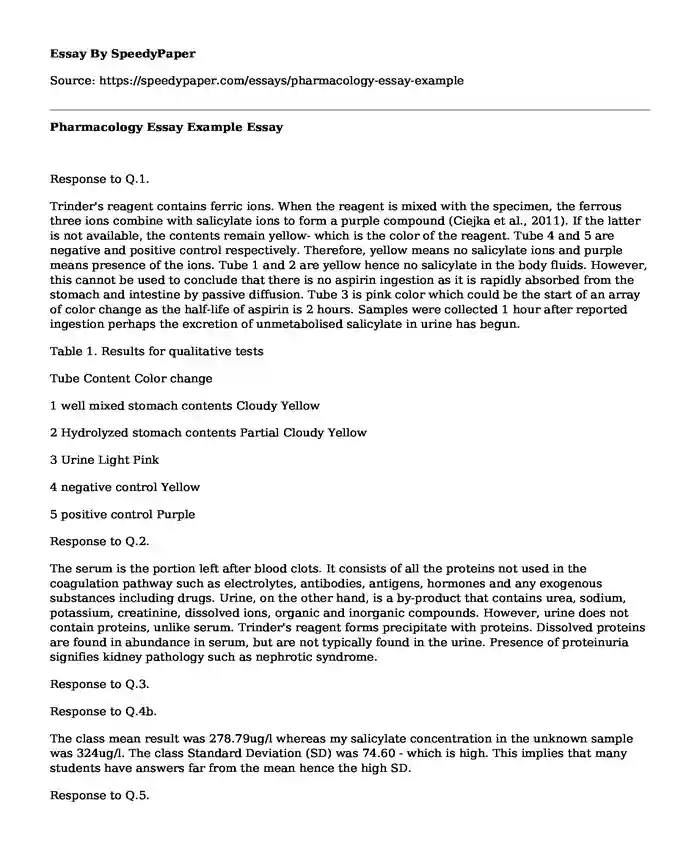
| Type of paper: | Report |
| Categories: | Pharmacology |
| Pages: | 3 |
| Wordcount: | 679 words |
Response to Q.1.
Trinder's reagent contains ferric ions. When the reagent is mixed with the specimen, the ferrous three ions combine with salicylate ions to form a purple compound (Ciejka et al., 2011). If the latter is not available, the contents remain yellow- which is the color of the reagent. Tube 4 and 5 are negative and positive control respectively. Therefore, yellow means no salicylate ions and purple means presence of the ions. Tube 1 and 2 are yellow hence no salicylate in the body fluids. However, this cannot be used to conclude that there is no aspirin ingestion as it is rapidly absorbed from the stomach and intestine by passive diffusion. Tube 3 is pink color which could be the start of an array of color change as the half-life of aspirin is 2 hours. Samples were collected 1 hour after reported ingestion perhaps the excretion of unmetabolised salicylate in urine has begun.
Table 1. Results for qualitative tests
Tube Content Color change
1 well mixed stomach contents Cloudy Yellow
2 Hydrolyzed stomach contents Partial Cloudy Yellow
3 Urine Light Pink
4 negative control Yellow
5 positive control Purple
Response to Q.2.
The serum is the portion left after blood clots. It consists of all the proteins not used in the coagulation pathway such as electrolytes, antibodies, antigens, hormones and any exogenous substances including drugs. Urine, on the other hand, is a by-product that contains urea, sodium, potassium, creatinine, dissolved ions, organic and inorganic compounds. However, urine does not contain proteins, unlike serum. Trinder's reagent forms precipitate with proteins. Dissolved proteins are found in abundance in serum, but are not typically found in the urine. Presence of proteinuria signifies kidney pathology such as nephrotic syndrome.
Response to Q.3.
Response to Q.4b.
The class mean result was 278.79ug/l whereas my salicylate concentration in the unknown sample was 324ug/l. The class Standard Deviation (SD) was 74.60 - which is high. This implies that many students have answers far from the mean hence the high SD.
Response to Q.5.
The therapeutic range of salicylate is 15-30 mg/dl (Waseem, 2017). The patient's salicylates level are within the therapeutic range.
Rheumatoid Arthritis (RA) is a persistent inflammatory arthritis. It is an autoimmune disease and is commoner in females. It is characterized by remissions and exacerbations. Its typical presentation is pain, joint swelling, and stiffness (Colledge, Walker, and Ralston, 2011, pg. 1088). It is a multisystem disease and because of the pain patients typically take NSAIDs such as aspirin. The patient might have taken an aspirin overdose as he or she is trying to reduce the pain associated with RA.
Response to Q.6.
Aspirin -acetylsalicylic acid- is an NSAID that has anti-inflammatory, antipyretic, and analgesic effects. Its actions are due to both the acetyl and the salicylate portions of the intact molecule as well as by the active salicylate metabolite. In addition, it also has antiplatelet activity and hence its use in people with a previous history of myocardial infarctions or those at risk of strokes to reduce chances of forming blood clots.
Aspirin irreversibly acetylates both cyclooxygenase (COX) 1 and 2 inhibiting their function. This reduces the production of thromboxane A2 and prostaglandins from arachidonic acid peripherally (Katzung, Masters, and Trevor, 2004, pg. 624). Reduction of the former reduces platelet aggregation. Prostaglandins normally reset the hypothalamus upper-temperature limit causing hotness of body, stimulate immune cells to cause inflammation and sensitizes nerve to pain consequently. Therefore, by inhibiting of prostaglandins, aspirin causes fever, inflammation, and pain relief.
Centrally, aspirin produces analgesic action in the hypothalamus. It also acts on the hypothalamus to produce antipyresis by increasing heat dissipation by causing vasodilation and increased peripheral blood flow.
References.
Ciejka, M., Nguyen, K., Bluth, M.H. and Dubey, E., 2016. Drug toxicities of common analgesic Medications in the emergency department. Clinics in laboratory medicine, 36(4).
Colledge, N.R., Walker, B.R., Ralston, S.H. and Principles, D.S., 2011. Practice of Medicine. Respiratory Disease, 21st Edition, Churchill Livinstone Elsevier, 2(011).
Katzung, B.G., Masters, S.B. and Trevor, A.J. eds., 2004. Basic & clinical pharmacology.
Waseem, M. 2017. Salicylate Toxicity Workup. https://emedicine.medscape.com/article/1009987-workup
Student initials Mean Salicylate estimate (g/ml)
1 360
2 267
3 330
4 111
5 325
6 282
7 134
8 270
9 410
10 237
11 185
12 365
13 318
14 290
15 260
16 250
17 286
18 225
19 325
20 330
21 353
22 275
23 250
24 235
25 222
26 262
27 370
28 293
29 375
30 370
31 308
32 295
33 218
34 93
MEAN 278.79
STANDARD DEVIATION 74.60
Cite this page
Pharmacology Essay Example. (2022, Mar 25). Retrieved from https://speedypaper.net/essays/pharmacology-essay-example
Request Removal
If you are the original author of this essay and no longer wish to have it published on the SpeedyPaper website, please click below to request its removal:
- Project Management Essay Example: The Move Plan and the Needs Analysis
- The Importance of Writing for Health Professionals - Essay Sample
- Free Essay on Human Resources in Hotels
- Role of Relationship Marketing In Competitive Marketing Strategy
- Essay Example about Chinese and Islamic Empires
- Drug Addiction: Substance Use Disorder & Its Effects - Paper Example
- Paper Sample on Post COVID-19 Life
Popular categories




